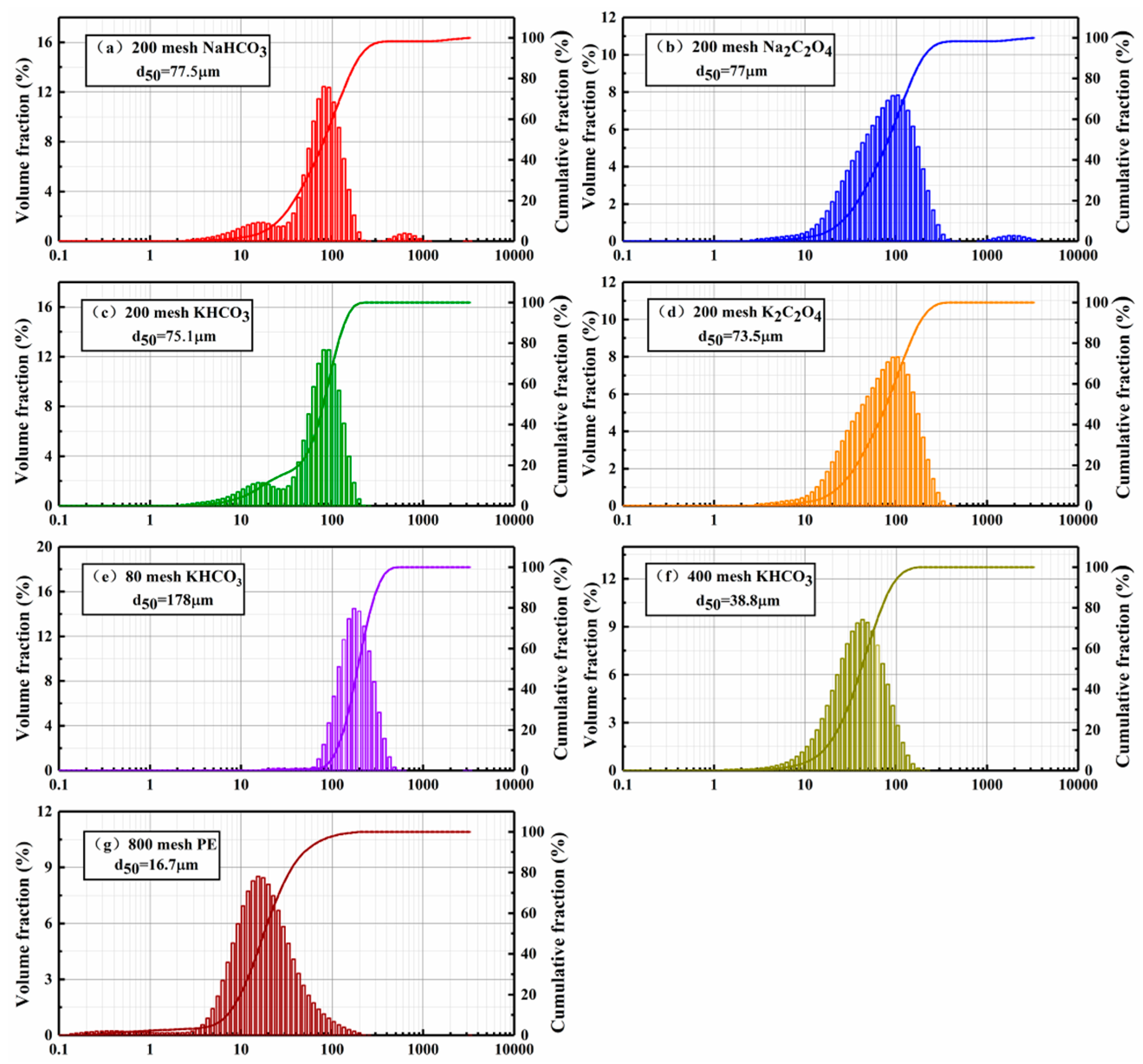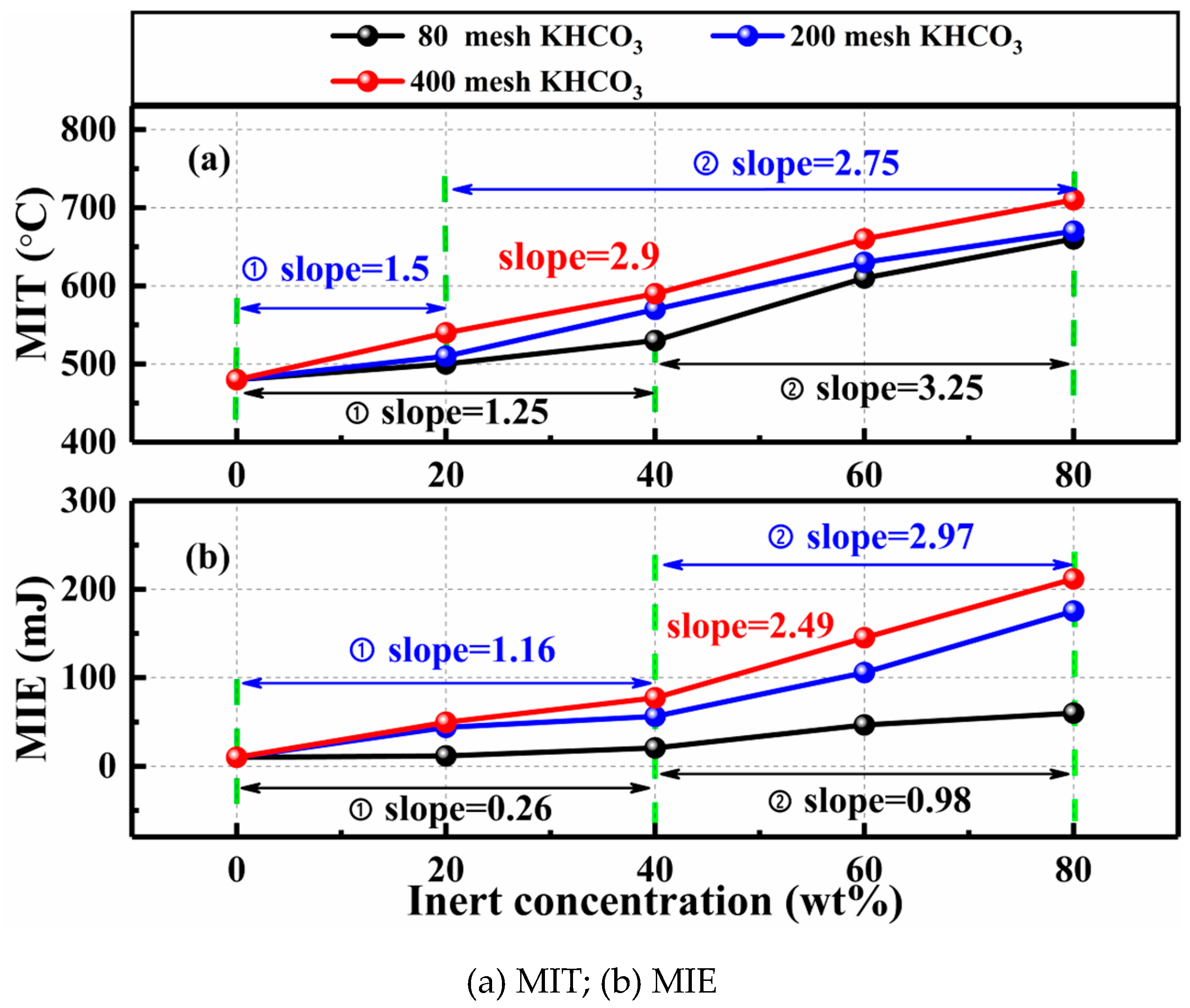Investigation into the Suppression Effects of Inert Powders on the Minimum Ignition Temperature and the Minimum Ignition Energy of Polyethylene Dust
Abstract
:1. Introduction
2. Materials and Experimental Work
2.1. Measurement of the Minimum Ignition Temperature
2.2. Measurement of the Minimum Ignition Energy
2.3. Materials
3. Results and Discussion
3.1. Effect of Inert Powders on the MIT and MIE of PE Dusts
3.2. Comparison between the Two Acid Radical Ions
3.2.1. Effects of NaHCO3 and Na2C2O4 on the MIT and MIE of PE Dusts
3.2.2. Effects of KHCO3 and K2C2O4 on the MIT and MIE of PE Dusts
3.3. Comparison between the Two Alkali Metal Ions
3.3.1. Effects of NaHCO3 and KHCO3 on the MIT and MIE of PE Dusts
3.3.2. Effects of Na2C2O4 and K2C2O4 on the MIT and MIE of PE Dusts
3.4. Mechanism Analysis
4. Conclusions
Author Contributions
Funding
Conflicts of Interest
Acronyms
| MIE | The minimum ignition energy |
| MIT | The minimum ignition temperature |
| PE | Polyethylene |
References
- Abbasi, M.R.; Shamiri, A.; Hussain, M.A. Dynamic modeling and molecular weight distribution of ethylene copolymerization in an industrial gas-phase fluidized-bed reactor. Adv. Powder Technol. 2016, 27, 1526–1538. [Google Scholar] [CrossRef] [Green Version]
- Yang, J.; Li, Y.H.; Yu, Y.; Zhang, Q.W.; Zheng, L.J.; Suo, Y.F.; Jiang, J.C. Experimental investigation of the inerting effect of CO2 on explosion characteristics of micron-size Acrylate Copolymer dust. J. Loss Prev. Process Ind. 2019, 62, 103979. [Google Scholar] [CrossRef]
- Yang, J.; Yu, Y.; Li, Y.H.; Zhang, Q.W.; Zheng, L.J.; Luo, T.Y.; Suo, Y.F.; Jiang, J.C. Inerting effects of ammonium polyphosphate on explosion characteristics of polypropylene dust. Process Saf. Environ. Prot. 2019, 130, 221–230. [Google Scholar] [CrossRef]
- Addai, E.K.; Gabel, D.; Krause, U. Experimental investigations of the minimum ignition energy and the minimum ignition temperature of inert and combustible dust cloud mixtures. J. Hazard. Mater. 2016, 307, 302–311. [Google Scholar] [CrossRef] [PubMed]
- Yu, Y.; Li, Y.; Zhang, Q.; Ni, W.; Jiang, J. Experimental investigation of the inerting effect of crystalline ii type ammonium polyphosphate on explosion characteristics of micron-size acrylates copolymer dust. J. Hazard. Mater. 2018, 344, 558–565. [Google Scholar] [CrossRef] [PubMed]
- Chunmiao, Y.; Amyotte, P.R.; Hossain, M.N.; Li, C. Minimum ignition energy of nano and micro ti powder in the presence of inert nano tio2 powder. J. Hazard. Mater. 2014, 274, 322–330. [Google Scholar] [CrossRef]
- Yu, H.; Wang, C.; Pang, L.; Cui, Y.; Chen, D. Inhibiting effect of coal fly ash on minimum ignition temperature of coal dust clouds. J. Loss Prev. Process Ind. 2019, 64, 24–29. [Google Scholar] [CrossRef]
- Liu, H.; Chen, H.Y.; Zhang, X.X.; Hu, Y.W.; Fan, C. Effects of different factors on the minimum ignition temperature of the mixed dust cloud of coal and oil shale. J. Loss Prev. Process Ind. 2019, 62, 103977. [Google Scholar] [CrossRef]
- Bu, Y.; Li, C.; Amyotte, P.; Yuan, W.; Yuan, C.; Li, G. Moderation of Al dust explosions by micro- and nano-sized Al2O3powder. J. Hazard. Mater. 2020, 381, 120968. [Google Scholar] [CrossRef]
- Birchall, J.D. On the mechanism of flame inhibition by alkali metal salts. Combust. Flame 1970, 14, 85–95. [Google Scholar] [CrossRef]
- Chen, X.K.; Lin, L.; Luo, Z.M.; Deng, J. Experiment study on controlling gas explosion by water-depressant. J. China Coal Soc. 2006, 31, 603–606. [Google Scholar]
- Dounia, O.; Vermorel, O.; Poinsot, T. Theoretical analysis and simulation of methane/air flame inhibition by sodium bicarbonate particles. Combust. Flame 2018, 193, 313–326. [Google Scholar] [CrossRef] [Green Version]
- Going, J.E.; Snoeys, J. Explosion protection with metal dust fuels. Process Saf. Prog. 2002, 21, 305–312. [Google Scholar] [CrossRef]
- Taveau, J.; Vingerhoets, J.; Snoeys, J.; Going, J.; Farrell, T. Suppression of metal dust deflagrations. J. Loss Prev. Process Ind. 2015, 36, 246–253. [Google Scholar] [CrossRef]
- Zhou, J.H.; Jiang, H.P.; Zhou, Y.H.; Gao, W. Flame suppression of 100 nm PMMA dust explosion by KHCO3 with different particle size. Process Saf. Environ. Prot. 2019, 132, 303–312. [Google Scholar] [CrossRef]
- Laffitte, P.; Bouchet, R. Suppression of explosion waves in gaseous mixtures by means of fine powders. Symp. (Int.) Combust. 1958, 7, 504–508. [Google Scholar] [CrossRef]
- Yang, K.; Ji, H.; Xing, Z.X.; Huang, W.Q.; Wang, Y.; Zhang, P. Inhibition of methane explosion by ultrafine water mist containing potassium oxalate. CIESC J. 2018, 69, 5359–5369. [Google Scholar]
- Liu, H.; Shang, K.D. Experimental study on inhibition of methane air diffusion flame by K2C2O4 solution. China Saf. Sci. J. 2016, 26, 46–51. [Google Scholar]
- European Committee for Standardization (ECS). EN50281-2-1: Electrical Apparatus for Use in the Presence of Combustible Dust, Part 2–1: Tests Methods–Methods for Determining the Minimum Ignition Temperatures of Dust; ECS: Brussels, Belgium, 2000. [Google Scholar]
- European Committee for Standardization (ECS). EN 13821, Potentially Explosive Atmospheres, Explosion Prevention and Protection, Determination of Minimum Ignition Energy of Dust/Air Mixtures; ECS: Brussels, Belgium, 2003. [Google Scholar]
- Amyotte, P.R.; Mintz, K.J.; Pegg, M.J.; Sun, Y.H.; Wilkie, K.I. Effects of methane admixture, particle size and volatile content on the dolomite inerting requirements of coal dust. J. Hazard. Mater. 1991, 27, 187–203. [Google Scholar] [CrossRef]
- Mishra, D.P.; Azam, S. Experimental investigation on effects of particle size, dust concentration and dust-dispersion-air pressure on minimum ignition temperature and combustion process of coal dust clouds in a G-G furnace. Fuel 2018, 227, 424–433. [Google Scholar] [CrossRef]
- Chen, X.; Zhang, H.; Chen, X.; Liu, X.; Niu, Y.; Zhang, Y.; Yuan, B. Effect of dust explosion suppression by sodium bicarbonate with different granulometric distribution. J. Loss Prev. Process Ind. 2017, 49, 905–911. [Google Scholar] [CrossRef]
- Janès, A.; Vignes, A.; Dufaud, O.; Carson, D. Experimental investigation of the influence of inert solids on ignition sensitivity of organic powders. Process Saf. Environ. Prot. 2014, 92, 311–323. [Google Scholar] [CrossRef]
- Denkevits, A.; Dorofeev, S. Explosibility of fine graphite and tungsten dusts and their mixtures. J. Loss Prev. Process Ind. 2006, 19, 174–180. [Google Scholar] [CrossRef]
- Chatrathi, K.; Going, J. Dust deflagration extinction. Process Saf. Prog. 2000, 19, 146–153. [Google Scholar] [CrossRef]
- Abbasi, T.; Abbasi, S.A. Dust explosions–cases, causes, consequences, and control. J. Hazard. Mater. 2007, 140, 7–44. [Google Scholar] [CrossRef]
- Jiang, H.; Bi, M.; Gao, W. Inhibition of aluminum dust explosion by NaHCO3 with different particle size distributions. J. Hazard. Mater. 2018, 344, 902–912. [Google Scholar] [CrossRef]












| Inert Powder | Median Particle Diameter (μm) | Specific Surface Area (m2/g) |
|---|---|---|
| NaHCO3 | 77.5 | 18.83 |
| Na2C2O4 | 77 | 1.419 |
| KHCO3 | 75.1 | 4.324 |
| K2C2O4 | 73.5 | 3.999 |
© 2020 by the authors. Licensee MDPI, Basel, Switzerland. This article is an open access article distributed under the terms and conditions of the Creative Commons Attribution (CC BY) license (http://creativecommons.org/licenses/by/4.0/).
Share and Cite
Lin, C.; Qi, Y.; Gan, X.; Feng, H.; Wang, Y.; Ji, W.; Wen, X. Investigation into the Suppression Effects of Inert Powders on the Minimum Ignition Temperature and the Minimum Ignition Energy of Polyethylene Dust. Processes 2020, 8, 294. https://doi.org/10.3390/pr8030294
Lin C, Qi Y, Gan X, Feng H, Wang Y, Ji W, Wen X. Investigation into the Suppression Effects of Inert Powders on the Minimum Ignition Temperature and the Minimum Ignition Energy of Polyethylene Dust. Processes. 2020; 8(3):294. https://doi.org/10.3390/pr8030294
Chicago/Turabian StyleLin, Chendi, Yingquan Qi, Xiangyang Gan, Hao Feng, Yan Wang, Wentao Ji, and Xiaoping Wen. 2020. "Investigation into the Suppression Effects of Inert Powders on the Minimum Ignition Temperature and the Minimum Ignition Energy of Polyethylene Dust" Processes 8, no. 3: 294. https://doi.org/10.3390/pr8030294





